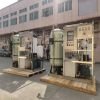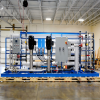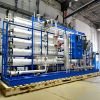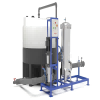In many parts of the world, freshwater is a scarce and valuable resource. As the global population continues to grow, and climate change exacerbates droughts, the need for alternative water sources has never been more pressing. One promising solution is seawater desalination, specifically small-scale desalination systems that can provide clean water for homes, communities, and businesses. In this article, we will explore the benefits, considerations, and applications of small-scale seawater desalination devices, and why they may be the future of sustainable water use.
Understanding Small-Scale Seawater Desalination
Seawater desalination is the process of removing salt and other impurities from seawater to make it suitable for human consumption and other uses. Traditionally, large desalination plants are used to produce freshwater on a massive scale, typically for cities or industrial purposes. However, with the advent of smaller, more efficient technologies, there is now an opportunity to scale down desalination systems for personal or localized use.
First, small-scale seawater desalination systems are designed to meet the needs of individual homes or small communities. These systems typically use reverse osmosis (RO) or distillation methods to filter out salt and other contaminants. Reverse osmosis systems are the most common in small-scale applications due to their high efficiency and relatively low maintenance requirements. Essentially, seawater is forced through a semi-permeable membrane that blocks the passage of salt and other impurities, leaving only clean, drinkable water behind.
Benefits of Small-Scale Seawater Desalination Systems
There are several advantages to using small-scale seawater desalination systems, particularly in areas facing water shortages.
1. Accessibility to Freshwater
One of the most significant benefits of these systems is their ability to provide access to freshwater in remote areas. In coastal regions where freshwater sources are limited, desalination can be a reliable and sustainable solution. This technology can also be particularly beneficial in island communities or coastal villages where natural freshwater resources are scarce.
2. Energy Efficiency and Sustainability
Modern small-scale desalination systems are designed to be energy-efficient. Many of them use solar power or other renewable energy sources to operate, making them a sustainable alternative to traditional water treatment methods. This not only reduces the environmental impact but also helps lower the operating costs, especially in off-grid areas.
3. Ease of Installation and Maintenance
Another notable advantage is the ease of installation and maintenance. Unlike large desalination plants, which require significant infrastructure and are often complex to maintain, small-scale systems are relatively simple to install and operate. Many systems are designed to be user-friendly, requiring minimal technical expertise.
Considerations When Choosing a Small-Scale Desalination System
While small-scale desalination offers numerous benefits, there are also several considerations to keep in mind before investing in a system.
1. Water Quality
Although desalination systems remove most of the salt and impurities from seawater, they may not eliminate all contaminants. It is important to assess the quality of the seawater in your area before choosing a system. For example, if the water contains heavy metals or other harmful substances, additional filtration steps may be needed.
2. Capacity and Output
The capacity of the desalination system should match the water needs of your household or community. Some small-scale systems are designed for single-family use, while others are large enough to support small villages or businesses. It is crucial to assess your daily water consumption to choose a system with the appropriate output.
3. Initial Cost and Maintenance
While small-scale desalination systems are generally affordable, the initial cost can vary depending on the technology and size of the system. Additionally, maintenance costs, such as replacing membranes in RO systems, can add up over time. Therefore, it’s important to consider both the initial investment and long-term maintenance costs.
Conclusion
In conclusion, small-scale seawater desalination systems offer a viable and sustainable solution to water scarcity, especially in coastal regions and remote areas. By providing access to freshwater with minimal environmental impact, these systems are paving the way for a more resilient and sustainable water future. However, it’s important to carefully assess the water quality, capacity, and costs before choosing a system. As technology continues to advance, small-scale desalination may become an even more accessible and efficient option for individuals and communities in need of clean water.

 MBR Membrane
MBR Membrane Reverse Osmosis Membrane
Reverse Osmosis Membrane Residential Ro Membrane
Residential Ro Membrane UF Membrane
UF Membrane Water Treatment Plant
Water Treatment Plant Residential Ro Machine
Residential Ro Machine Brackish Ro System
Brackish Ro System Sea water system/SW RO plant
Sea water system/SW RO plant Membrane Cleaning System(CIP)
Membrane Cleaning System(CIP) Consumables Accessories
Consumables Accessories
